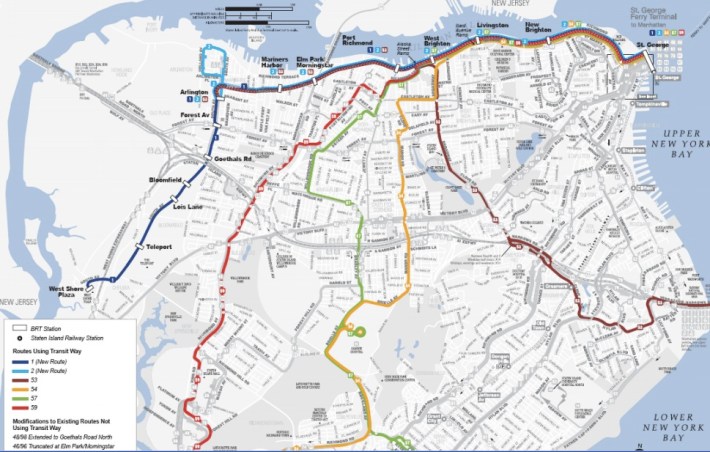
The MTA announced yesterday that if it builds a new rapid transit line along Staten Island's North Shore, it will opt for bus rapid transit over light rail, an MTA spokesperson told Streetsblog. The obstacle now, as always, is money.
The proposed BRT line would run along Staten Island's North Shore, which is twice as densely populated as the rest of the island. Even though no rapid transit exists in the area, over a third of residents take transit to work, relying entirely on buses.
Along much of the route, the busway will use the existing right-of-way of now-shuttered rail service. In some places the tracks are still there; in others, they are overgrown with vegetation or even underwater. At the western terminus of the right-of-way, the system would turn inland and run to the West Shore Plaza in mixed traffic.
In a presentation delivered yesterday at the Snug Harbor Cultural Center, [PDF] the MTA outlined its decision to pursue bus improvements over light rail. Though light rail would be marginally faster than buses -- and likely higher-capacity -- the busway option has two decided advantages, according to the presentation.

First, by using an "open" busway design, in which multiple bus routes can shared the dedicated transit infrastructure before branching off, the busway can speed trips for people across more of the island. As such, the MTA predicts higher ridership on the BRT option than on light rail. Second, the MTA estimates the capital costs of the busway to be far lower than light rail: $371 million versus $645 million.
North Shore bus riders would see their travel times to the St. George ferry terminal cut by around half.
At the same time as the MTA is pursuing the restoration of rapid transit to the North Shore, the city Department of City Planning and Economic Development Corporation are at work on a wide-ranging plan to revitalize the area, including pedestrian and bicycle improvements and efforts to promote mixed-use development. If both the planning and transit improvements move forward, the area could be truly transformed.
At least on the transit side, however, this project isn't going anywhere without money (it also needs to go through design and engineering work and environmental review before it could be "shovel-ready"). MTA chief Joe Lhota has repeatedly said that the debt-strapped authority's next capital plan will focus on improving the existing system, not expanding it. While a Staten Island busway is an order of magnitude cheaper than current MTA megaprojects like the Second Avenue Subway, right now there's no indication at all of how the MTA will fund its capital needs.





